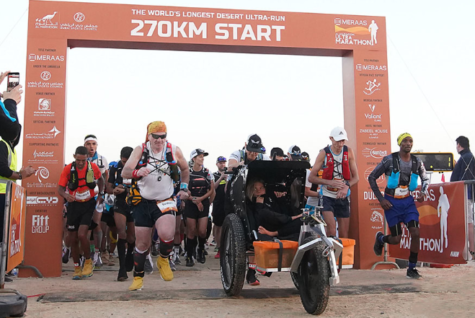Another Thirty Miles To Go: Ultramarathons and How to Prepare
Over the past few years, a growing number of runners in the U.S. participate in these races for reasons beyond the competition. Originating from Greek messengers, ultramarathoning is yet another example of humans pushing their physical and mental boundaries.
A man once ran 26.2 miles and died.
However, today, thousands of people in the United States alone, not all with professional expertise, prove they can do the same without dying.
The man in question, according to the most commonly told story, is Pheidippides, infamous for his fatal 25-mile run from Marathon to Athens, hence the word “marathon” being designated to the long-distance race today. Pheidippides was one of many hemerodromoi, Greek for “courier” or “messenger,” who ran for days on end to deliver messages across long distances, as they sacrificed hours of sleep and ran across rocky terrain. He was tasked with running from Athens to Sparta in order to ask for Spartan aid in combat against Persian soldiers in the Battle of Marathon. After receiving Spartan reinforcements, Pheidippides ran back to Athens, and delivered his message.
It is argued whether or not it was actually Pheidippides or another messenger who ran the 25 miles from Marathon to Athens. Regardless, the story was popularized in Robert Browning’s poem Pheidippides (1897) which detailed his supposed death and appealed to Michel Bréal who suggested the first long-distance run in Greece for the 1896 Olympic Games. This marked the first marathon.
When taking into consideration Pheidippides’ personal run – which spanned over about 300 miles – he much more resembles a modern ultramarathoner.
An ultramarathon is any race that exceeds the standard 26.2-mile marathon. The most common races are the 50 kilometer (K), 50-mile, 100-K, and 100-mile races. The longest ultramarathons can span over 200 miles. Ultramarathon running requires months of a strict training regime in order to better prepare the runner’s body for what is to come.
A more overlooked part of training to become an ultramarathoner is altering your diet. Previously compared to competitive eaters, ultramarathoners have to consider eating and fueling themselves throughout a race without discomfort. It is important that potential racers train their stomachs within the training period for the race. Much like the running itself and building up distance, ultramarathoners should establish a baseline that tells them what their bodies can handle. Training your stomach includes recognizing your habits, such as what foods you usually eat before a run. Slowly incorporating more calories and solid foods into your diet will build up your ability to stomach food over a long-distance run. These tests do not have to be a part of every day training but can happen once or twice a week, in order to build up stamina. Training across multiple months helps find what a runner may or may not be comfortable with; while some runners may be keen to consume sweet foods across the entire race, others may prefer more savory foods instead.
Throughout the race, an ultra runner’s body uses up its energy but also demands more. Aid stations, which may appear every couple of miles, provide water, food, and first aid care. In training, ultra runners learn to eat and drink on the run, but finishing an ultramarathon does not mean never stopping or slowing down. Ultramarathons cover distances that go up to and beyond 100 miles; the large distance may make it difficult to gauge a pace that works for each individual. Although someone will start off at top speed, it does not mean they can maintain it for the remainder of their race. It is important to remember that not everyone will run the same race or even be able to. Running longer distances in training can help determine a runner’s comfortable pace. Speed training builds on the comfortable pace and makes it more manageable over an extended period.
Some ultramarathoners including professional ultramarathoner and record holder Ann Trason split up their races into smaller distances that become the first goal, the second, and so on. Aid stations can serve as these checkpoints that will help keep track of the goal pace, how much of the race is left, and what should be done differently by the next station.
When training for ultramarathons, it is important to consider all conditions that will appear during the race, beforehand. It is important to be aware of what is to come; if you were to run on a mountain, it would be helpful to train on rocky terrain, and so on. Many training schedules span four to six months and involve gradually pushing the pace and distance your body can undergo. For example, if you choose to run a 50-mile ultramarathon and start by running an 8-mile long run on the weekends, by the end of four months some training schedules will have you run up to or beyond 32 miles. These training schedules typically have you build up a base and continue to work on it.

A study by Psychology Research and Behavior Management, Motivation in Ultra-Marathon Runners, tested the motivations of 1,539 Polish runners through a questionnaire of 56 questions known as MOMS. Within the 56 questions are 4 sections (psychological, achievement, social, and physical) each pertaining to a broader potential goal among runners. The psychological section related to motivations regarding self-esteem, life meaning, and coping. Achievement pertained to competition and personal goal achievement; social was associated with affiliation and recognition; and physical was related to health and weight concerns. The results showed that ultramarathoners consistently had higher scores for life meaning and affiliations with lower scores in weight concern, personal goal achievement, and self-esteem compared to their non-running counterparts.
In an interview with Dean Karnazes, professional ultramarathoner and author of Ultramarathon Man: Confessions of an All-Night Runner, he said “running an ultramarathon is very different from running a 5K; running 5K is more of a race, and running an ultramarathon is more of an experience. Some people don’t like to run because it is not very fun, but running an ultramarathon is a different kind of experience; it’s more of an adventure than running.” He finds that he runs ultras because of the exposure to nature and the beauty of the outdoors. For many, ultramarathoning is a “safe place” because of how much focus it requires. He continued, saying that many people run ultramarathons to escape some sort of trauma or burden in their life, and they look to ultramarathon running in order to relieve the pain.
Running for hours on end is no easy feat – especially when it gets over the 5-hour mark. When running an ultramarathon, it is important to stay alert to how your body is responding to the long distance and other conditions that appear. As with anything that has you push your personal boundaries, it’s difficult to drive yourself past these limits. Running an ultramarathon often suggests a lot of time in solitude and is built on self-reliance. In that time, a runner can build up both physical and mental toughness that sticks with them throughout the race.
But pushing your boundaries does not always imply combatting the pain for prolonged periods of time; as Karnazes said, “you get to learn about yourself because you’re tested in ways that you’ve never been tested before.” There is an infinite list of how people push themselves. Whether the reason for doing so is a personal or shared experience, ultramarathon running is certainly one of them.
Running for hours on end is no easy feat – especially when it gets over the 5-hour mark.
Tori Wee is an Editor-in-Chief for ‘The Science Survey.’ She especially appreciates the literary and storytelling aspect of journalism that comes through...

